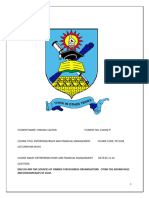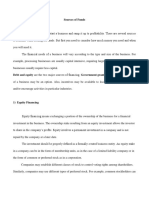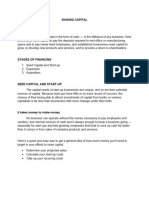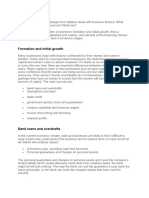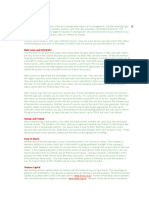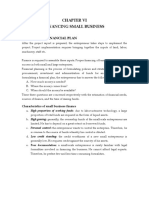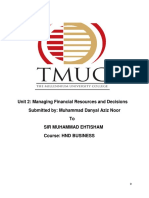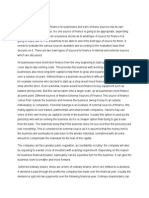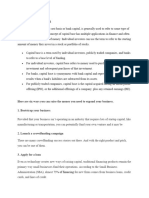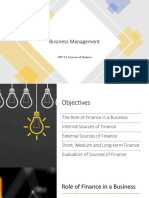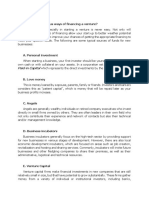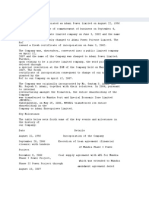What Is Finance?: Raise Money Sale Debt Equity
What Is Finance?: Raise Money Sale Debt Equity
Uploaded by
kiranaishaCopyright:
Available Formats
What Is Finance?: Raise Money Sale Debt Equity
What Is Finance?: Raise Money Sale Debt Equity
Uploaded by
kiranaishaOriginal Description:
Original Title
Copyright
Available Formats
Share this document
Did you find this document useful?
Is this content inappropriate?
Copyright:
Available Formats
What Is Finance?: Raise Money Sale Debt Equity
What Is Finance?: Raise Money Sale Debt Equity
Uploaded by
kiranaishaCopyright:
Available Formats
finance Definitions (2) 1. A branch of economics concerned with resource allocation as well as resource management, acquisition and investment.
Simply, finance deals with matters related to money and the markets. 2. To raise money through the issuance and sale of debt and/or equity.
What is Finance?
Finance is the set of activities dealing with the management of funds. More specifically, it is the decision of collection and use of funds. It is a branch of economics that studies the management of money and other assets. Finance is also the science and art of determining if the funds of an organization are being used properly. Through financial analysis, companies and businesses can take decisions and corrective actions towards the sources of income and the expenses and investments that need to be made in order to stay competitive. Sources of finance for a start-up business sources of finance is where a business can get money from. there are two types where money can be found internal and external. internal are things like the owner's capital and external are things like loans.
Introduction Often the hardest part of starting a business is raising the money to get going. The entrepreneur might have a great idea and clear idea of how to turn it into a successful business. However, if sufficient finance cant be raised, it is unlikely that the business will get off the ground.
Raising finance for start-up requires careful planning. The entrepreneur needs to decide: How much finance is required? When and how long the finance is needed for? What security (if any) can be provided? Whether the entrepreneur is prepared to give up some control (ownership) of the start-up in return for investment?
The finance needs of a start-up should take account of these key areas: Set-up costs (the costs that are incurred before the business starts to trade) Starting investment in capacity (the fixed assets that the business needs before it can begin to trade) Working capital (the stocks needed by the business e.g. r raw materials + allowance for amounts that will be owed by customers once sales begin) Growth and development (e.g. extra investment in capacity)
One way of categorising the sources of finance for a start-up is to divide them into sources which are from within the business (internal) and from outside providers (external).
Sources Of Business Finance
The initial investment that an owner puts into a business is known as capital. The source of this capital may include money from savings, redundancy, inheritance, investments, winnings etc. When the business becomes established Internal sources
The main internal sources of finance for a start-up are as follows: Personal sources These are the most important sources of finance for a start-up, and we deal with them in more detail in a later section. Retained profits This is the cash that is generated by the business when it trades profitably another important source of finance for any business, large or small. Note that retained profits can generate cash the moment trading has begun. For example, a start-up sells the first batch of stock for 5,000 cash which it had bought for 2,000. That means that retained profits are 3,000 which can be used to finance further expansion or to pay for other trading costs and expenses. Share capital invested by the founder The founding entrepreneur (/s) may decide to invest in the share capital of a company, founded for the purpose of forming the start-up. This is a common method of financing a start-up. The founder provides all the share capital of the company, retaining 100% control over the business. The advantages of investing in share capital are covered in the section on business structure. The key point to note here is that the entrepreneur may be using a variety of personal sources to invest in the shares. Once the investment has been made, it is the company that owns the money provided. The shareholder obtains a return on this investment through dividends (payments out of profits) and/or the value of the business when it is eventually sold. A start-up company can also raise finance by selling shares to external investors this is covered further below.
External sources Loan This can take several forms, but the most common are a bank loan or bank overdraft.
capital
A bank loan provides a longer-term kind of finance for a start-up, with the bank stating the fixed period over which the loan is provided (e.g. 5 years), the rate of interest and the timing and amount of repayments. The bank will usually require that the start-up provide some security for the loan, although this security normally comes in the form of personal guarantees provided by the entrepreneur. Bank loans are good for financing investment in fixed assets and are generally at a lower rate of interest that a bank overdraft. However, they dont provide much flexibility. A bank overdraft is a more short-term kind of finance which is also widely used by start-ups and small businesses. An overdraft is really a loan facility the bank lets the business owe it money when the bank balance goes below zero, in return for charging a high rate of interest. As a result, an overdraft is a flexible source of finance, in the sense that it is only used when needed. Bank overdrafts are excellent for helping a business handle seasonal fluctuations in cash flow or when the business runs into short-term cash flow problems (e.g. a major customer fails to pay on time). Two further loan-related sources of finance are worth knowing about: Share capital outside investors For a start-up, the main source of outside (external) investor in the share capital of a company
is friends and family of the entrepreneur. Opinions differ on whether friends and family should be encouraged to invest in a start-up company. They may be prepared to invest substantial amounts for a longer period of time; they may not want to get too involved in the day-to-day operation of the business. Both of these are positives for the entrepreneur. However, there are pitfalls. Almost inevitably, tensions develop with family and friends as fellow shareholders. Business angels are the other main kind of external investor in a start-up company. Business angels are professional investors who typically invest 10k - 750k. They prefer to invest in businesses with high growth prospects. Angels tend to have made their money by setting up and selling their own business in other words they have proven entrepreneurial expertise. In addition to their money, Angels often make their own skills, experience and contacts available to the company. Getting the backing of an Angel can be a significant advantage to a start-up, although the entrepreneur needs to accept a loss of control over the business. You will also see Venture Capital mentioned as a source of finance for start-ups. You need to be careful here. Venture capital is a specific kind of share investment that is made by funds managed by professional investors. Venture capitalists rarely invest in genuine start-ups or small businesses (their minimum investment is usually over 1m, often much more). They prefer to invest in businesses which have established themselves. Another term you may here is private equity this is just another term for venture capital. A start-up is much more likely to receive investment from a business angel than a venture capitalist.
Personal sources As mentioned earlier, most start-ups make use of the personal financial arrangements of the founder. This can be personal savings or other cash balances that have been accumulated. It can be personal debt facilities which are made available to the business. It can also simply be the found working for nothing! The following notes explain these in a little more detail.
Savings and other nest-eggs An entrepreneur will often invest personal cash balances into a start-up. This is a cheap form of finance and it is readily available. Often the decision to start a business is prompted by a change in the personal circumstances of the entrepreneur e.g. redundancy or an inheritance. Investing personal savings maximises the control the entrepreneur keeps over the business. It is also a strong signal of commitment to outside investors or providers of finance. Re-mortgaging is the most popular way of raising loan-related capital for a start-up. The way this works is simple. The entrepreneur takes out a second or larger mortgage on a private property and then invests some or all of this money into the business. The use of mortgaging like this provides access to relatively low-cost finance, although the risk is that, if the business fails, then the property will be lost too. . Borrowing from friends and family This is also common. Friends and family who are supportive of the business idea provide money either directly to the entrepreneur or into the business. This can be quicker and cheaper to arrange (certainly compared with a standard bank loan) and the interest and repayment terms may be more flexible than a bank loan. However, borrowing in this way can add to the stress faced by an entrepreneur, particularly if the business gets into difficulties. Credit cards This is a surprisingly popular way of financing a start-up. In fact, the use of credit cards is the most common source of finance amongst small businesses. It works like this. Each month, the entrepreneur pays for various business-related expenses on a credit card. 15 days later the credit card statement is sent in the post and the balance is paid by the business within the credit-free period. The effect is that the business gets access to a free credit period of aroudn30-45 days!
, capital may be increased by retaining an amount of profit that the business earns. These are all internal sources of finance.
External sources of finance are available for businesses to draw upon if internal sources are not sufficient. These external sources of finance can be classified into three main categories. These are short term, medium term and long term sources.
Short Term Sources of Finance
Short term sources of finance are usually used to provide additional working capital which is needed to fund the day to day activities of a business. These activities may include replacing stock which has been sold and therefore converted back into cash. Short term finance is generally considered to be over a period of one year or less. These sources of finance include:
Overdrafts- This is a type of bank loan is set up on an account which can be used if required to provide additional working capital for a short period of time when there is a cash deficit. This type of loan tends to attract a high interest rate which makes them quite expensive. How much of a risk the bank considers the loan to be will an affect the interest rate considerably which is often determined by a credit rating score. If the business needs money for a fixed period of time which is less than one year it could be more appropriate to set up a short term loan from a bank or even borrow money from family or friends. Banks may charge a set up fee for a bank loan and will be paid back in instalments. Some sort of collateral or security for the loan will usually be required by lenders so that if the business defaults on its payment it can recover any outstanding payments by taking claim to any assets than were used as collateral. For new businesses the collateral used is usually the business owners house or car. Trade credit- This is provided by trade creditors who are a supplier whom the business has purchased goods or services from on a credit basis. This means that the business does not have to pay its supplier straight away and has until the end of the credit period to pay for its purchases. The credit period is a length of time specified by the supplier which is based on a businesss credit rating. This is usually between thirty and ninety days. Suppliers may offer a discount on purchase for prompt payment before or by the due date. Trade credit is not a direct source of finance but it does make it possible for money already within the business to be directed elsewhere until it is needed to pay creditors. Factoring- This is where finance is raised against trade debtors. These are customers who have purchased goods or services from a business on credit but have not yet paid and have usually breached their credit terms. A factoring organisation which is usually a bank or another financial institution will assess how credit worthy the debtors are and proceed to attempt to collect the debts on behalf of the business. This is done for a fee which is determined by the amount of financial risk involved regarding the debtor. Once the debtors have been passed
on, the business can get the value of the invoice minus the fee immediately (dependent on the agreed terms).
Medium Term Sources of Finance
Medium term sources of finance are usually repaid over a period of five to seven years. This is usually used to purchase assets that are expected to generate income for the business over the medium term which may include office equipment, plant, fixtures and fittings or vehicles. This type of finance is secured against business assets or the owners personal assets depending on what type of company it is. These sources of finance include:
Medium term loan- This could be obtained from a bank, a government scheme or friends and family. It would most likely be used to purchase an asset over a fixed period of time which will be linked to the expected economic life of the asset. The conditions of the loan are similar to that of an overdraft or short term loan. Hire purchase- This is a more flexible approach to traditional borrowing. HP allows a purchaser to start using an asset as soon as a deposit has been paid. The deposit represents the first payment of a number of instalments which are paid over a specified period of time at regular intervals. The ownership of the asset does not pass to the purchaser until the final instalment has been paid. This type of finance can carry quite a high interest rate but may be better for a business as payments are spread out over time. Leasing- This can be used to acquire assets at a lower cost than would be necessary to purchase outright. Leases are usually paid monthly or yearly. A business may use this option is the residual value of an asset is likely to be uncertain when it comes to selling the asset or if an asset is only required for a certain period of time.
Long Term Sources of Finance
Long term sources of finance are used to obtain assets that are expected to provide economic gain or benefit to the business in the long term. This type of finance is usually considered to be longer than seven years and can be divided into two categories which are debt finance and equity finance. These are the main sources of debt finance:
Long term loan- This would be suitable for capital investment in fixed assets such as plant and machinery or to expand the business. Mortgage- A form of long term loan that is used to purchase land or premises. A mortgage in usually provided by a financial institution such as a bank or building society. They have a specified time frame over a number of years where the loan has to be paid back which is usually around twenty-five to thirty years. The interest
rate can either be fixed or variable. The amount owed can either be paid in instalments or at the end of the term of the loan. Debenture- The most common type of long term loan taken out by a limited liability company. Repayment is usually made in full at a fixed date in the distant future. The holder of the debenture could be a private or corporate investor and typically receives a fixed rate of interest. Debentures are lower risk for the investor than an equity agreement and can be sold on the stock exchange.
Equity Finance
Equity finance refers to finance raised by the selling of ordinary shares. This makes it possible for only limited liability companies to use this source of finance. Below are the types of equity finance: Public limited companies can sell shares on the stock exchange to raise capital. The rules of the stock exchange are very strict and involve a lot of regulation . On the stock market there is a minimum amount of shares that have to be issued, trading records are required and there is a minimum market capitalization. Formal venture capital- These are from corporate investors such as pension funds, and they generally provide equity finance for new businesses or for situations where there is a turnaround such as a management buyout. Only investments that offer high returns to offset the high risks will interest a venture capitalist. Informal venture capital- Business angels generally provide this type of equity finance for small to medium size enterprises. A business angel is usually a wealthy individual who want to invest in a privately owned business which are usually private limited companies. In conclusion, the source of finance that a business will try to obtain is dependent on the reason the finance is needed. A business would have to examine what its requirements are and what its financial position is at the time. Only then could they make the correct decision as what type of finance will be right for them.
You might also like
- Business Finance Q4 Module 3Document21 pagesBusiness Finance Q4 Module 3randy magbudhi80% (15)
- HDFC Loan Closure010Document3 pagesHDFC Loan Closure010Aditya Adi Singh100% (1)
- Competitive AdvantageDocument27 pagesCompetitive Advantagekiranaisha100% (1)
- The Marketing AuditDocument19 pagesThe Marketing AuditkiranaishaNo ratings yet
- Sources of Finance For Startups and SMEsDocument4 pagesSources of Finance For Startups and SMEsTawanda Percy MutsandoNo ratings yet
- Part 3Document14 pagesPart 3vinayakbelwadeNo ratings yet
- Finance - Html#Ixzz3Su1Owgre Attribution Non-Commercial Share AlikeDocument11 pagesFinance - Html#Ixzz3Su1Owgre Attribution Non-Commercial Share AlikeDeeNo ratings yet
- Bussiness Chapter 6-1Document5 pagesBussiness Chapter 6-1Bethelhem YetwaleNo ratings yet
- Chapter 6Document18 pagesChapter 6AYNETU TEREFENo ratings yet
- Business FinanceDocument7 pagesBusiness Financegodwillinno1997No ratings yet
- Theory Lec5Document13 pagesTheory Lec52023-1-95-018No ratings yet
- Discuss Five Sources FinanceDocument6 pagesDiscuss Five Sources Financen02315027fNo ratings yet
- Entrep MGT Module 6 2024Document9 pagesEntrep MGT Module 6 2024Marc Josua CagayanNo ratings yet
- c5-92 FinanceDocument4 pagesc5-92 FinanceGhulam HassanNo ratings yet
- Financial StarategiesDocument31 pagesFinancial StarategiesDonna Zandueta-TumalaNo ratings yet
- Raising CapitalDocument6 pagesRaising CapitalMark Christian CancinoNo ratings yet
- 06 Business Financing - Principles of BusinessDocument14 pages06 Business Financing - Principles of Businessoeric3343No ratings yet
- Sources of Capital For A New Business Venture EP SHP 12Document3 pagesSources of Capital For A New Business Venture EP SHP 12noorusama05No ratings yet
- Chapter 6 Business FinancingDocument16 pagesChapter 6 Business Financingtegegne abdissaNo ratings yet
- EquityDocument5 pagesEquityAkansha NarayanNo ratings yet
- Business Finance TADocument9 pagesBusiness Finance TAOlivier MNo ratings yet
- Financing The New VentureDocument17 pagesFinancing The New VentureKaustubh ShilkarNo ratings yet
- Entrepreneurship CH 6Document21 pagesEntrepreneurship CH 6Meklit TenaNo ratings yet
- Seed CapitalDocument5 pagesSeed CapitalScroll with deepriyaNo ratings yet
- Internal Sources of FinanceDocument10 pagesInternal Sources of FinanceRahul JagiasiNo ratings yet
- NOE-071 Session 2.5 Types and Sources of Financing For Start-Up BusinessesDocument5 pagesNOE-071 Session 2.5 Types and Sources of Financing For Start-Up BusinessesYogesh Kumar GaurNo ratings yet
- Sources of FinanceDocument3 pagesSources of Financealok19886No ratings yet
- Module 8 Elect 2Document13 pagesModule 8 Elect 2Franz Ervy MallariNo ratings yet
- Entrepreneurship AssignmentDocument7 pagesEntrepreneurship AssignmentMazhar ArfinNo ratings yet
- Chapter 4Document14 pagesChapter 4Yosef KetemaNo ratings yet
- Chapter 25 BusinessDocument5 pagesChapter 25 BusinessTitan27OPSNo ratings yet
- The Need For Capital and Sources of FinanceDocument6 pagesThe Need For Capital and Sources of FinanceKhamica ArcherNo ratings yet
- Bba Unit IvDocument31 pagesBba Unit IvShubham PrasadNo ratings yet
- Raising Finance: Your Business PlanDocument3 pagesRaising Finance: Your Business PlanallaNo ratings yet
- Unit 2: Managing Financial Resources and Decisions Submitted By: Muhammad Danyal Aziz Noor To Sir Muhammad Ehtisham Course: HND BusinessDocument45 pagesUnit 2: Managing Financial Resources and Decisions Submitted By: Muhammad Danyal Aziz Noor To Sir Muhammad Ehtisham Course: HND BusinessjojoNo ratings yet
- MFRD EssayDocument6 pagesMFRD Essaydoll3kittenNo ratings yet
- Chapter 5 Entrepreneurial FinanceDocument53 pagesChapter 5 Entrepreneurial FinancekyrastenkeNo ratings yet
- WK 12 Expansion Capital Among Other TopicsDocument2 pagesWK 12 Expansion Capital Among Other Topicsrobertwangai64No ratings yet
- Topic 2.1 - Raising Finance Learning Outcome The Aim of This Section Is For Students To Understand The FollowingDocument8 pagesTopic 2.1 - Raising Finance Learning Outcome The Aim of This Section Is For Students To Understand The FollowinggeorgianaNo ratings yet
- Banks and Other Commercial Lenders: 3 Effective Ways To Utilize Your Working Capital WiselyDocument2 pagesBanks and Other Commercial Lenders: 3 Effective Ways To Utilize Your Working Capital Wiselymariel buyagonNo ratings yet
- Chapter 5Document11 pagesChapter 5Xael XaelNo ratings yet
- 3 Is Financial Aspect of The StudyDocument7 pages3 Is Financial Aspect of The StudyKirby DuliguesNo ratings yet
- CHP 3.1 Sources of FinanceDocument35 pagesCHP 3.1 Sources of FinanceDana MneimneNo ratings yet
- Financing Financial Resources and DecisionsDocument8 pagesFinancing Financial Resources and DecisionsmakkahihiaNo ratings yet
- Individuals AssignmentDocument7 pagesIndividuals AssignmentQuỳnh NhưNo ratings yet
- Venture Capial and Angel FinancingDocument8 pagesVenture Capial and Angel Financingshaunakgaddime1No ratings yet
- New Venture FinancingDocument19 pagesNew Venture FinancingGaurav SharmaNo ratings yet
- E8 Business FinanceDocument8 pagesE8 Business FinanceTENGKU ANIS TENGKU YUSMANo ratings yet
- Unit 2 Venture FinanceDocument8 pagesUnit 2 Venture Financelaket64875No ratings yet
- Sources of FundDocument16 pagesSources of FundRonak ShahNo ratings yet
- A Report On Analysis of Venture Capital As A Source of FinanceDocument21 pagesA Report On Analysis of Venture Capital As A Source of Financearun883765No ratings yet
- Research Papers On Internal and External Sources of FinanceDocument8 pagesResearch Papers On Internal and External Sources of Financevvjrpsbnd100% (1)
- Debt Vs Equity FinancingDocument6 pagesDebt Vs Equity FinancingJo Angeli100% (2)
- Definition of Business FinanceDocument4 pagesDefinition of Business FinanceClovisNo ratings yet
- Sources of Financing Business IdeasDocument11 pagesSources of Financing Business IdeasГена КрокодилNo ratings yet
- Cash Flow and Credit and Background InvestigationDocument5 pagesCash Flow and Credit and Background Investigationjan francis marianoNo ratings yet
- Sources of CapitalDocument6 pagesSources of CapitalSumon Bera0% (1)
- Sources of CapitalDocument3 pagesSources of CapitalALBERT AMONCIO ALONZONo ratings yet
- Best Sources of FinanceDocument14 pagesBest Sources of Financegodwillinno1997No ratings yet
- What Is 'Startup Capital': (1) Your Own / Company's CashDocument13 pagesWhat Is 'Startup Capital': (1) Your Own / Company's CashLian Emerald SmithNo ratings yet
- Raising MoneyDocument57 pagesRaising MoneysaritaNo ratings yet
- A - Internal Sources: I. Various Sources of Finance Available To Phat DucDocument12 pagesA - Internal Sources: I. Various Sources of Finance Available To Phat DucnothingtosayNo ratings yet
- Performance ManagementDocument9 pagesPerformance ManagementkiranaishaNo ratings yet
- Performance ManagementDocument9 pagesPerformance ManagementkiranaishaNo ratings yet
- Topic: What Is The Purpose of Planning? Analyse The Key Factors That Influence The HRP Processes?Document11 pagesTopic: What Is The Purpose of Planning? Analyse The Key Factors That Influence The HRP Processes?kiranaishaNo ratings yet
- Examine The Process of Recruitment, Selection and Appointment. How Can These Process Ensure The Uses of The Optimum Potential AppointeesDocument25 pagesExamine The Process of Recruitment, Selection and Appointment. How Can These Process Ensure The Uses of The Optimum Potential AppointeeskiranaishaNo ratings yet
- CorporateDocument23 pagesCorporatekiranaishaNo ratings yet
- Managing Information SystemDocument19 pagesManaging Information SystemkiranaishaNo ratings yet
- People ManagementDocument18 pagesPeople ManagementkiranaishaNo ratings yet
- CorporateDocument23 pagesCorporatekiranaishaNo ratings yet
- Staff Retention ToolkitDocument82 pagesStaff Retention Toolkitkiranaisha100% (1)
- Cloud ComputingDocument25 pagesCloud ComputingkiranaishaNo ratings yet
- Models of Change ManagementDocument12 pagesModels of Change ManagementkiranaishaNo ratings yet
- Barriers Entrepreneurship and Business CreationDocument49 pagesBarriers Entrepreneurship and Business Creationparekh_ameeNo ratings yet
- Assumptions Underlying The Concept of Comparative AdvantageDocument7 pagesAssumptions Underlying The Concept of Comparative AdvantagekiranaishaNo ratings yet
- About The IMFDocument6 pagesAbout The IMFkiranaishaNo ratings yet
- Chapter Three: Research MethodologyDocument20 pagesChapter Three: Research MethodologyRogerKYChan100% (1)
- Gross Domestic Product Market ValueDocument1 pageGross Domestic Product Market ValuekiranaishaNo ratings yet
- What Are The Objectives of BudgetingDocument7 pagesWhat Are The Objectives of BudgetingkiranaishaNo ratings yet
- Key Facts Statement 4605593Document7 pagesKey Facts Statement 4605593Chiranjeet PANDITNo ratings yet
- PAG IBIgDocument2 pagesPAG IBIgdocgilbertNo ratings yet
- Barerra V Lorenzo - ValixDocument2 pagesBarerra V Lorenzo - ValixVon Lee De LunaNo ratings yet
- Week 3 FinmanDocument10 pagesWeek 3 FinmanZavanna LaurentNo ratings yet
- Washington International School: Examinee Code: Date of Exam: Score/EquivalentDocument6 pagesWashington International School: Examinee Code: Date of Exam: Score/EquivalentGenelle Mae MadrigalNo ratings yet
- Entrepreneurship and Starting A Small Business: Because Learning Changes EverythingDocument73 pagesEntrepreneurship and Starting A Small Business: Because Learning Changes EverythingMark NjorogeNo ratings yet
- The Star News Shopper - May 19, 2015Document24 pagesThe Star News Shopper - May 19, 2015The Star NewsNo ratings yet
- Updated ResumeDocument3 pagesUpdated ResumeBhasker RamachandraNo ratings yet
- Loan Eligibility PredictionDocument12 pagesLoan Eligibility PredictionUddhav ChaliseNo ratings yet
- Income From House PropertyDocument47 pagesIncome From House PropertyNidhi GuptaNo ratings yet
- Strategy Corp - Case GuideDocument16 pagesStrategy Corp - Case GuideDiego BKNo ratings yet
- Assets & Liabilities Management AT The Union Co-Operative Bank LTDDocument21 pagesAssets & Liabilities Management AT The Union Co-Operative Bank LTDapluNo ratings yet
- Company History - Adani PowerDocument4 pagesCompany History - Adani PowerKrishna PatilNo ratings yet
- Manappuram Finance Investor PresentationDocument43 pagesManappuram Finance Investor PresentationabmahendruNo ratings yet
- UntitledDocument63 pagesUntitledEnock KapoteNo ratings yet
- Lai 122543763Document37 pagesLai 122543763dheeraj828580No ratings yet
- How To Process A Loan Along Its LifecycleDocument85 pagesHow To Process A Loan Along Its LifecycleMadhu Devarasetti50% (2)
- Spouses Reyes & Maravillo v. Heirs of Malance (Acedillo: Credit Digest)Document2 pagesSpouses Reyes & Maravillo v. Heirs of Malance (Acedillo: Credit Digest)Francisco Ashley AcedilloNo ratings yet
- F6mys 2012 Dec ADocument7 pagesF6mys 2012 Dec AMohd IrfanNo ratings yet
- KCSE 2021 - Movers Transport SystemDocument47 pagesKCSE 2021 - Movers Transport SystemDAILY IMPARTATION TV100% (2)
- HDFC Bank AnnualReport 2012 13Document180 pagesHDFC Bank AnnualReport 2012 13Rohan BahriNo ratings yet
- Sarfaesi Work Manual Book-Actual PDFDocument43 pagesSarfaesi Work Manual Book-Actual PDFDikshita GuhaNo ratings yet
- Financial Statement: Anne Attorney John DoeDocument11 pagesFinancial Statement: Anne Attorney John DoeBenoitNo ratings yet
- Chap 5Document23 pagesChap 5selva0% (1)
- LPB Unit - IDocument17 pagesLPB Unit - ITony StarkNo ratings yet
- SBI Home Loans - Regular Home Loan1Document3 pagesSBI Home Loans - Regular Home Loan1RupakDasNo ratings yet
- Consumer Reports - December 2020 USADocument76 pagesConsumer Reports - December 2020 USAKev Advan100% (2)
- Trust ReceiptDocument29 pagesTrust ReceiptJanis NadalNo ratings yet











